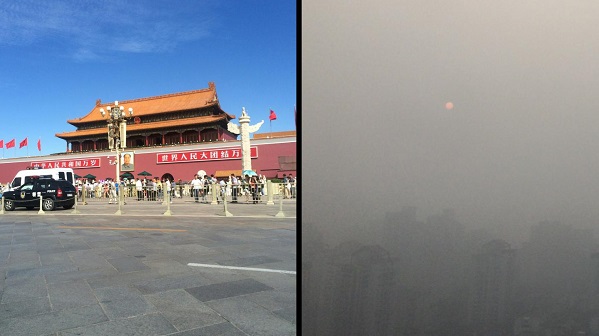Fewer industrial firms would violate environmental legislation and a higher number would adopt cleaner technologies if environmental authorities would focus their monitoring efforts on companies with the most environmentally damaging technology. At a societal level, such a strategy would mean less pollution at the same or a lower cost of monitoring, according to a new doctoral thesis from the University of Gothenburg’s School of Business, Economics and Law.
‘Since all people suffer from air pollution and global climate change, our research is relevant to everybody. But our findings are particularly important to the public authorities in charge of monitoring businesses’ compliance with environmental regulations,’ says Xiao-Bing Zhang, who in his doctoral thesis in environmental economics has looked at cooperation and how it affects the climate. He has given particular attention to paradoxes related to environment policy.
 APEC Blue vs. Beijing Smog. Two new concepts – ‘APEC Blue’ and ‘Beijing Smog’ – were coined in Chinese social media in November 2014 when Beijing hosted the APEC (Asia-Pacific Economic Cooperation) summit. To improve the air quality during the summit, the government closed factories, mandated days-off from work and imposed restrictions on car traffic. And the sky turned unusually blue, but at an enormous cost. Image credit: Jun Yang/EfD China.
APEC Blue vs. Beijing Smog. Two new concepts – ‘APEC Blue’ and ‘Beijing Smog’ – were coined in Chinese social media in November 2014 when Beijing hosted the APEC (Asia-Pacific Economic Cooperation) summit. To improve the air quality during the summit, the government closed factories, mandated days-off from work and imposed restrictions on car traffic. And the sky turned unusually blue, but at an enormous cost. Image credit: Jun Yang/EfD China.
One such paradox is that firms’ compliance with environmental regulations is generally high even if inspections occur infrequently and fines for non-compliance are rare and small. In other words, surprisingly many companies choose to follow the rules even if the risk of getting busted is low.
For environmental authorities with limited, tax-funded budgets, it is of course important that the monitoring and sanctioning efforts are carried out as cost-efficiently as possible. Xiao-Bing Zhang has analysed a type of control system that takes both the technology used by companies and how well the firms comply with environmental legislation into account.
‘It’s fair to assume that companies that have already adopted cleaner technologies are better at complying with regulations, and that it therefore would be a better investment to focus the monitoring on this group in order to get a larger share of all companies to comply with environmental legislation,’ says Xiao-Bing Zhang.
‘However, our results show that the net benefit to society is maximised by focusing the monitoring on the companies that use the most environmentally damaging technologies. This type of control system encourages businesses to invest in greener technology. The total share of companies that use more modern and environmentally friendly technology increases and the emissions decrease. And the monitoring costs go down.’
Next, Xiao-Bing Zhang will apply his findings in studies of industrial firms in Beijing. The sky over the Chinese capital is a clear indicator that restrictions and monitoring of emissions can be effective. Prior to the National People’s Congress in March, the Asian Pacific Economic Cooperation summit last autumn and the 2008 Olympics, the Chinese government set out to reduce the city’s smog and air pollution in order to avoid negative publicity. To this end, some factories were ordered to close temporarily, mandatory days off from work were introduced, and car traffic was restricted. And it worked – the sky turned blue. But only until the restrictions were lifted.
Reference(s):
Story: Greener industry if environmental authorities change strategy | University of Gothenburg — March 27, 2015











Comments